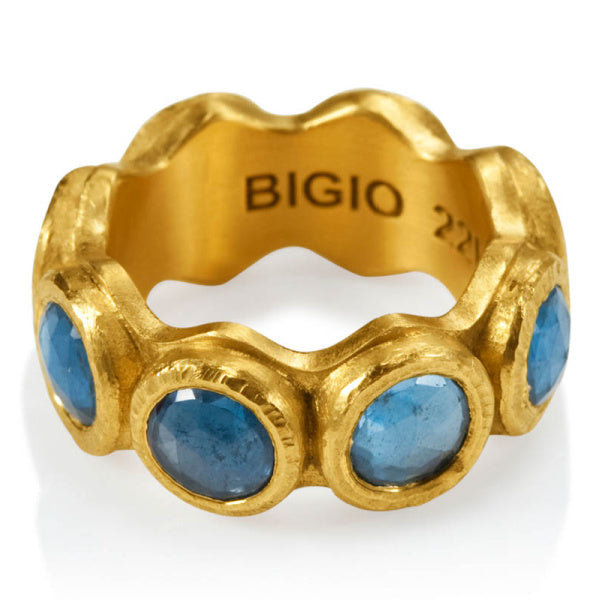Photos: Jack Bigio
For some people, a gleaming jewel set in precious stone is a treasure. For Jack Bigio, who transitioned from working in Wall Street at Goldman Sachs and Credit Suisse to creating fine jewelry, the process of creating these treasures has itself become a precious exploration of beauty, art, and, more broadly, what he truly values.
The impression a jeweler makes with his or her work — think Tiffany’s, Cartier, Van Cleef & Arpels, Harry Winston — can often be conjured by the line’s name alone. The familiar shapes and swoops, the particular glitter and glint.
The same is true of Bigio’s work: the shapes, the settings, the style are instantly recognizable, yet timeless. New York Makers recently sat down with Bigio to learn more about his inspiration, craft, and process. Please read on to learn more about how his conception of value has been transformed during the pandemic.
NEW YORK MAKERS: Going from leading a Wall Street firm as CEO to creating fine jewelry is quite a leap. How did it happen?
JACK BIGIO: I retired in 2003, and I took a year off to catch my breath. Towards the end of that year, in lieu of going back to School to get a Masters in Architecture, I took a class in jewelry making at the 92nd Street Y (92Y) and was immediately fascinated by the way it incorporates engineering, fine art, sculpture, and craftsmanship. I’ve always enjoyed working with my hands, and I love design. It started as a personal project, something I enjoyed doing for my two daughters and my late wife, but soon friends and family began commissioning me.
NYM: Did you immediately think about leveraging it into a new career?
JB: Yes and no. I wanted to enjoy the process and that meant developing relationships with stone dealers and other craftspeople, to ensure that everything was of the highest quality, from responsible sources. And I wanted to enjoy the process. I consider jewelry to be wearable sculpture. To me, it was about enjoying the inspiration and process, and not worrying about the business end.
NYM: In other words, you don’t see the line turning into a major jewelry house.
JB: No. I have a beautiful studio NOHO in Manhattan, and my goal was from the outset to sell enough jewelry to cover my overhead.


NYM: What inspires you?
JB: I look at architecture first and foremost. I would say my jewelry is most inspired by architecture; it’s very geometric. I also study sculpture, and look at textiles, paintings, and stained and colored glass for inspiration. I also study modern and contemporary jewelry and jewelry dating all the way back to ancient times. The most timeless and beautiful creations don’t bear the imprint of the era in which they’re made, and that’s my goal. But, in addition to the look, I think of the design of the clasps and mechanisms. It’s very important to me that everything functions and doesn’t break.
NYM: Now, as a jewelry lover myself, I could not help but notice that prices aren’t on your website. Why is that?
JB: Because the website is really more of a calling card. I sell maybe 5%-10% of my line through the website, and that’s only after someone emails me to inquire. Most of my work is custom. I speak to the clients, see what they want, and most of the time, despite my having a vast number of gems on hand, I source the exact type of gem or jewel they want.
NYM: You work with diamonds, rubies, gold. How much do your items sell for?
JB: The least expensive and simplest start at $500; the most intricate is around $100,000. Most items go for between $5,000 and $10,000.

NYM: What do you make the most of?
JB: Earrings are by far the most popular, then rings, bracelets, and necklaces. Cufflinks, unfortunately, don’t sell well in the U.S. Wearing cufflinks isn’t a big thing for men here. I wear a lot of cufflinks, though. Several of my collectors have accumulated over 20 pieces, all according to their wishes. In between commissions, I make my own pieces, many of which ended up in my partner's and daughters collections.
NYM: The pandemic has been a strange time for creators. How has it affected your process?
JB: Profoundly. During this time I think the entire world has spent a lot of time thinking about what matters to them, what they value.
My family and I went out to the Hamptons and spent a lot of time together there, walking on the beach. Together, we collected maybe 10,000 shells, many of them fragments over months of walks. Then we’d come home, and I’d sift through them for hours. It was very therapeutic. From that number, I eventually winnowed it down to 10 in my mind perfect, but broken, shells. It was a remarkable experience, and deeply memorable. It was a difficult time, but a time I wanted to memorialize.
I’ve created a necklace from those 10 shells, set in 22-carat gold, which is very valuable. All together, with the cost of the materials, the shells of course are zero, but the gold is valuable, and my time and labor, I’d have to charge $20,000 to make this necklace worthwhile. It would have been faster, easier, and perhaps more cost-effective to source 10 perfect jewels. But to me, this necklace, the experience of making it and what it represents, is priceless. I did not make it to sell it. Instead, I gave it to my partner as a token of appreciation for the extra love and attention during the pandemic.




It may not have a year ago, but it certainly does now.
Many people have suffered during the pandemic — their health, their finances, their family, their career. The story is different for everyone. But so are the surprising gifts and riches we’ve walked away with.


Leave a comment